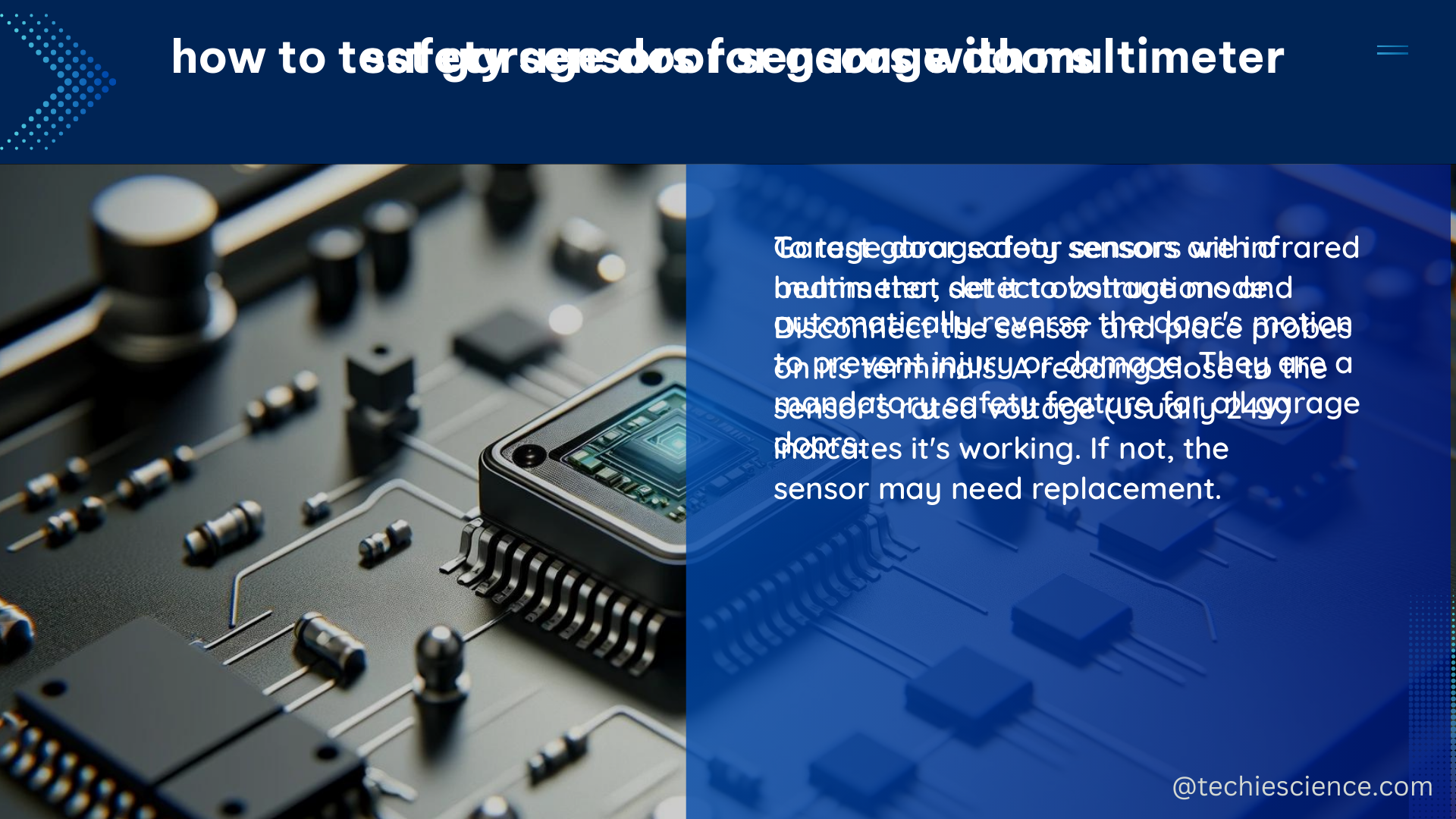Garage door safety sensors are a critical component of modern garage door systems, ensuring the safety of individuals and property by preventing the door from closing if an obstruction is detected. These sensors work by creating an invisible infrared beam of light, with one sensor acting as the sending unit and the other as the receiving unit. When the beam is interrupted, the door automatically stops closing and reverses direction, mitigating the risk of damage or injury.
Technical Specifications of Garage Door Safety Sensors
The technical specifications of garage door safety sensors can vary across manufacturers and models, but there are several key parameters to consider:
Operating Range
The operating range of garage door safety sensors refers to the maximum distance between the sending and receiving units that allows the infrared beam to be detected. This distance typically ranges from 20 to 45 feet, depending on the sensor model.
Beam Width
The beam width of the infrared light emitted by the sending unit is another important specification. This parameter determines the coverage area of the sensor and can range from 1 to 4 inches, with narrower beams providing more precise detection.
Response Time
The response time of the safety sensors is the time it takes for the system to detect an obstruction and stop the door from closing. This is a critical factor for ensuring the safety of individuals and property, with response times typically ranging from 0.1 to 0.5 seconds.
Power Requirements
Garage door safety sensors require a specific voltage and current to operate, with most models designed to work with 12-24 VDC or 24 VAC power supplies. The power consumption of the sensors can range from 10 to 50 mA, depending on the model.
Operating Environment
Garage door safety sensors must be able to function reliably in a variety of environmental conditions, including temperature and humidity. The operating temperature range for most sensors is between -40°F (-40°C) to 150°F (65°C), with a humidity range of 0-95% non-condensing.
Certifications
To ensure the safety and reliability of garage door safety sensors, it is essential to look for models that are UL 325 certified. This certification indicates that the sensors meet the latest safety standards and requirements.
DIY Garage Door Safety Sensor Installation

Installing garage door safety sensors can be a DIY project for those with some experience in home improvement and basic electrical work. Here is a step-by-step guide to the installation process:
-
Locate the Mounting Brackets: The mounting brackets for the safety sensors are typically located on the garage door track, near the bottom of the door.
-
Mount the Sensors: Attach the sending and receiving units to the mounting brackets, ensuring that they are level and facing each other. The sensors should be positioned 4-6 inches above the floor, as per the manufacturer’s recommendations.
-
Connect the Wires: Connect the wires from the safety sensors to the garage door opener, following the manufacturer’s instructions carefully. This may involve connecting the sensors to a terminal block or directly to the opener’s control board.
-
Test the Sensors: After the installation is complete, test the sensors by placing a cardboard box or other object in the garage opening, directly between the sending and receiving units. Attempt to close the door, and it should immediately stop and reverse direction.
It is essential to follow the manufacturer’s instructions precisely during the installation process, as improper wiring or sensor alignment can result in the sensors not functioning correctly, posing a safety hazard.
Troubleshooting Garage Door Safety Sensors
If the garage door safety sensors are not working as expected, there are several troubleshooting steps you can take:
-
Sensor Misalignment: Check if the sending and receiving units are properly aligned. If one of the sensors is blinking, it may indicate a misalignment, and you will need to adjust the position of the sensor.
-
Sensor Obstruction: Ensure that there are no obstructions between the sending and receiving units, such as cobwebs, dust, or debris. Clean the sensor lenses with a mild cleaner and a soft cloth.
-
Sensor Wiring: Inspect the wiring connecting the sensors to the garage door opener. Look for any signs of damage, such as fraying or breaks in the insulation, and replace the wiring if necessary.
-
Sensor Replacement: If the sensors are still not functioning correctly after troubleshooting, they may need to be replaced. Contact the manufacturer or a professional garage door technician for assistance.
By understanding the technical specifications and proper installation of garage door safety sensors, you can ensure the safety of your home and family while also maintaining the reliable operation of your garage door system.
References
- Guide to Garage Door Safety Sensors
- Garage Door Safety Sensors Forum Discussion
- Garage Door Safety Sensor Guide

The lambdageeks.com Core SME Team is a group of experienced subject matter experts from diverse scientific and technical fields including Physics, Chemistry, Technology,Electronics & Electrical Engineering, Automotive, Mechanical Engineering. Our team collaborates to create high-quality, well-researched articles on a wide range of science and technology topics for the lambdageeks.com website.
All Our Senior SME are having more than 7 Years of experience in the respective fields . They are either Working Industry Professionals or assocaited With different Universities. Refer Our Authors Page to get to know About our Core SMEs.